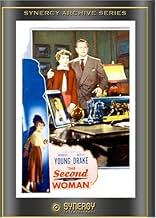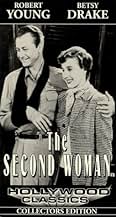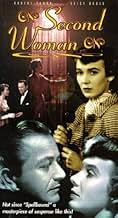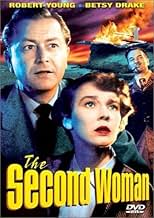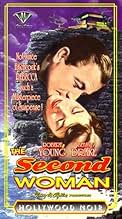CALIFICACIÓN DE IMDb
6.3/10
1.5 k
TU CALIFICACIÓN
Agrega una trama en tu idiomaIn flashback from a 'Rebecca'-style beginning: Ellen Foster, visiting her aunt on the California coast, meets neighbor Jeff Cohalan and his ultramodern clifftop house.In flashback from a 'Rebecca'-style beginning: Ellen Foster, visiting her aunt on the California coast, meets neighbor Jeff Cohalan and his ultramodern clifftop house.In flashback from a 'Rebecca'-style beginning: Ellen Foster, visiting her aunt on the California coast, meets neighbor Jeff Cohalan and his ultramodern clifftop house.
Jason Robards Sr.
- Stacy Rogers
- (as Jason Robards)
Jimmie Dodd
- Mr. Nelson
- (as Jimmy Dodd)
Smoki Whitfield
- Porter
- (escenas eliminadas)
Walter Bacon
- Country Club Guest
- (sin créditos)
Vince Barnett
- Giovanni Strobini
- (sin créditos)
Paul Bradley
- Country Club Guest
- (sin créditos)
- Dirección
- Guionistas
- Todo el elenco y el equipo
- Producción, taquilla y más en IMDbPro
Opiniones destacadas
Robert Young is one seemingly unlucky guy in "The Second Woman," a 1950 film also starring Betsy Drake, Morris Carnovsky, John Sutton, Florence Bates and Henry O'Neill. This was probably a 'B' noir; like "Shining Victory" and "The Uninvited," it is reminiscent of "Rebecca" - in fact, the beginning narration is basically a paraphrase of "Last night I dreamt I went to Manderlay." This film even goes so far as to have Florence Bates playing Drake's aunt; she was Mrs. DeWinter's employer in "Rebecca." Drake is Ellen Foster, a young woman en route by train to visit her aunt when she meets her aunt's attractive neighbor, Jeff Cohalon (Young). He's built a fantastic house that, her aunt informs Ellen, no one has ever been in. He built it for his bride-to-be, and she was killed in a car accident before the wedding. Since then, several people - his almost father-in-law, Ben (O'Neill), to whom Jeff is like a son, and a psychiatrist, Dr. Hartley (Carnovsky) have been concerned about Jeff. He seems absent-minded and moody. Then strange things begin to happen to Jeff - he has to shoot his horse when it breaks its leg apparently while in its stall; his dog dies; the color on a painting he owns suddenly fades; and roses he brings into the house die immediately. Ellen, who works with actuarial tables, is darn suspicious - there is too much bad luck, and either Jeff himself or someone who wants him destroyed is behind it.
"The Second Woman" is a decent film with good, if unexciting, acting. Robert Young made several noirs in the '40s, and he did them well - you really don't know here if he's sinister or if he's a victim. Drake is a bland costar. Carnovsky, O'Neill, Sutton and Bates give good support. Sutton strikes the right note as a man who hates Jeff.
Like dozens and dozens of post-World War II, there is an emphasis on psychology. Considering what our soldiers went through in World War II, it's not surprising that it was a hot topic. Here the big word is paranoia. But as anyone will tell you, just because you're paranoid doesn't mean someone's not out to get you.
"The Second Woman" is a decent film with good, if unexciting, acting. Robert Young made several noirs in the '40s, and he did them well - you really don't know here if he's sinister or if he's a victim. Drake is a bland costar. Carnovsky, O'Neill, Sutton and Bates give good support. Sutton strikes the right note as a man who hates Jeff.
Like dozens and dozens of post-World War II, there is an emphasis on psychology. Considering what our soldiers went through in World War II, it's not surprising that it was a hot topic. Here the big word is paranoia. But as anyone will tell you, just because you're paranoid doesn't mean someone's not out to get you.
The Second Woman is a stylish mystery thriller staring second tier leads Robert Young and Betsy Drake and directed by second tier director James V. Kern. But there is nothing second rate about the finished product. This movie is visually and dramatically stimulating from beginning to end.
Young plays an architect brooding over the death of his fiancé in an auto crash in which he was the driver the previous year. After a series of apparent accidents, including a suspicious injury to his horse and a fire at his house, it appears that either someone is out to get him, or he is actually doing destructive things to himself because he is a dangerously off-his-nut paranoiac. The local doctor (Morris Carnovsky) believes the latter. His newly acquired girl friend (Drake), who works in statistical studies for an insurance company, turns detective to prove it is the former. The mystery unfolds at a leisurely pace at first but gradually builds tension with surprising twists and turns of the plot. As with any good thriller, you begin to suspect everyone. A brooding, almost Gothic mood is maintained by Joseph Nussbaum's haunting Tchaikovsky-based score and Hal Mohr's alternately dark and luminous black and white cinematography. Frequent shots of the surf crashing on the lonely rocks of the Central California shore help set the forlorn ambiance. Kern's direction is precise, dialog is intelligent, editing smooth. Young and Drake are charming, and they get expert support from Carnovsky, Henry O'Neil, Florence Bates, and John Sutton.
The Second Woman successfully blends elements of mystery, noir, Gothic, and romantic melodrama. Though released in July 1950, its sensuous style and feel seem to belong more to the l940's than to the 'fifties. But when decades are accounted properly, the year 1950 is actually the last year of the decade we nickname "the forties". In any case it was made near the end of an era. Due to collapse of the studio systems, death and retirement of key personnel, adverse changes in public taste, and other factors, by the end of the 1950's they would no longer be able to make pictures as classy and entertaining as The Second Woman.
Top entertainment from Hollywood's Golden Era.
Young plays an architect brooding over the death of his fiancé in an auto crash in which he was the driver the previous year. After a series of apparent accidents, including a suspicious injury to his horse and a fire at his house, it appears that either someone is out to get him, or he is actually doing destructive things to himself because he is a dangerously off-his-nut paranoiac. The local doctor (Morris Carnovsky) believes the latter. His newly acquired girl friend (Drake), who works in statistical studies for an insurance company, turns detective to prove it is the former. The mystery unfolds at a leisurely pace at first but gradually builds tension with surprising twists and turns of the plot. As with any good thriller, you begin to suspect everyone. A brooding, almost Gothic mood is maintained by Joseph Nussbaum's haunting Tchaikovsky-based score and Hal Mohr's alternately dark and luminous black and white cinematography. Frequent shots of the surf crashing on the lonely rocks of the Central California shore help set the forlorn ambiance. Kern's direction is precise, dialog is intelligent, editing smooth. Young and Drake are charming, and they get expert support from Carnovsky, Henry O'Neil, Florence Bates, and John Sutton.
The Second Woman successfully blends elements of mystery, noir, Gothic, and romantic melodrama. Though released in July 1950, its sensuous style and feel seem to belong more to the l940's than to the 'fifties. But when decades are accounted properly, the year 1950 is actually the last year of the decade we nickname "the forties". In any case it was made near the end of an era. Due to collapse of the studio systems, death and retirement of key personnel, adverse changes in public taste, and other factors, by the end of the 1950's they would no longer be able to make pictures as classy and entertaining as The Second Woman.
Top entertainment from Hollywood's Golden Era.
Intriguing psychological thriller which reflects the forties zeitgeist when psychonanalysis was the craze (see "spellbound" " the dark mirror" "secret beyond the door"...)Because he feels responsible for the death of his fiancée in a car crash ,Jeff is brooding .And he's a victim of strange incidents (he has to shoot his horse whose front leg is broken, his dog is poisoned ) ;"it cannot be a coincidence " says Helen (who plays the role of Ingrid Bergman in "spellbound" although she's not a shrink ) .When the unfortunate man's house is burnt , all coincidence must be ruled out:
Is it a self-inflicted retribution ("he wants to be punished for what he's done) ,as the friendly doctor says , warning Helen and her aunt who accomodates him after the fire against a man who may become dangerous :he destroys everything he likes , and he loves you!
Or is there a criminal mind behind these strange events : hence a whodunit side: is it Ben,the late fiancée's father who treats Jeff like his own son?Keith the philanderer? Or the doctor himself ?
The screenplay sustains suspense throughout and the ending makes sense ; Robert Young as a brooding wistful man down on his luck and Betsy Drake, as headstrong energetic Helen come up to scratch.
Is it a self-inflicted retribution ("he wants to be punished for what he's done) ,as the friendly doctor says , warning Helen and her aunt who accomodates him after the fire against a man who may become dangerous :he destroys everything he likes , and he loves you!
Or is there a criminal mind behind these strange events : hence a whodunit side: is it Ben,the late fiancée's father who treats Jeff like his own son?Keith the philanderer? Or the doctor himself ?
The screenplay sustains suspense throughout and the ending makes sense ; Robert Young as a brooding wistful man down on his luck and Betsy Drake, as headstrong energetic Helen come up to scratch.
I really enjoyed this film. It has a fairly believable premise. I do have a little trouble with the self-sacrifice angle and the idea of taking things to the grave that could be dealt with, but it has lots of suspense and a cool ending. Robert Young is carrying around a secret. He is being daily harassed by someone. His dog is killed, his house is burned, his horse is harmed (to the point where it needs to be destroyed), and his livelihood (as an architect) is being compromised. He meets a young woman who makes him happy, but she can't convince him to come clean. There is a plot to portray him as psychotic (actually paranoid), He seems to have some handle on everything but won't say what it is. There is excellent cinematography. The pacing is quite good. I have to admit I never suspected what was going on. It's a captivating film. The acting is quite good. Oh, yes, as I see these films, I have seen the presence of Jimmy Dodd who was the head Mousketeer on the old Mickey Mouse Club show of the fifties. His acting portfolio is rather extensive though unimpressive.
The Second Woman (AKA: Ellen) is directed by James V. Kern and co- written by Mort Briskin and Robert Smith. It stars Robert Young, Betsy Drake, John Sutton, Florence Bates, Morris Carnovsky and Henry O'Neil. Music is by Joseph Nussbaum and cinematography by Hal Mohr.
Architect Jeff Cohalan (Young) is a troubled man, after the mysterious death of his fiancée in a car crash, he has been acting strangely and lives a lonely life at the Hilltop House he designed for his bride to be. When he meets Ellen Foster (Drake), things perk up as he becomes attracted to her. But he is constantly plagued by bad luck, something which doesn't go unnoticed by Ellen, who suspects that Jeff may not be the victim of paranoia, but of something sinister perpetrated by outside forces
The Coast of Kings.
If you can get away from the looming presence of such great films like Gaslight and Rebecca, then James Kern's movie holds some Gothic noir rewards. The house at the centre of tale is a modern development, which is a shame as it goes against the coastal atmosphere lifting up from the Carmel-On-Sea location that was used for these parts of the film, but otherwise there's a strong brooding mystery bubbling away throughout. As the bizarre instances of misfortune start to mount up on Jeff Cohalan, with director Kern showing a good appreciation of pacing, it builds up a menacing head of steam and then unravels a better than adequate denouement.
Vivian, Vivian, Vivian
Young and Drake inevitably tug at a romantic thread, but they make for an engaging couple and Drake especially gets her teeth into a female role of intelligent substance. John Sutton files in for some decent caddish quotient and Bates and O'Neil add some professionally elder support. Mohr's (Bullets or Ballets/The Lineup) photography is the key, consistently at one with the psychological beats of the plotting, his lighting compositions make the film seem far more higher in production value than it was.
A tale of memory lapses, pet bothering, depression, ugly real estate, dastards and romance, is nicely cloaked by ominous coastal atmospherics and Tchaikovsky! 7/10
Architect Jeff Cohalan (Young) is a troubled man, after the mysterious death of his fiancée in a car crash, he has been acting strangely and lives a lonely life at the Hilltop House he designed for his bride to be. When he meets Ellen Foster (Drake), things perk up as he becomes attracted to her. But he is constantly plagued by bad luck, something which doesn't go unnoticed by Ellen, who suspects that Jeff may not be the victim of paranoia, but of something sinister perpetrated by outside forces
The Coast of Kings.
If you can get away from the looming presence of such great films like Gaslight and Rebecca, then James Kern's movie holds some Gothic noir rewards. The house at the centre of tale is a modern development, which is a shame as it goes against the coastal atmosphere lifting up from the Carmel-On-Sea location that was used for these parts of the film, but otherwise there's a strong brooding mystery bubbling away throughout. As the bizarre instances of misfortune start to mount up on Jeff Cohalan, with director Kern showing a good appreciation of pacing, it builds up a menacing head of steam and then unravels a better than adequate denouement.
Vivian, Vivian, Vivian
Young and Drake inevitably tug at a romantic thread, but they make for an engaging couple and Drake especially gets her teeth into a female role of intelligent substance. John Sutton files in for some decent caddish quotient and Bates and O'Neil add some professionally elder support. Mohr's (Bullets or Ballets/The Lineup) photography is the key, consistently at one with the psychological beats of the plotting, his lighting compositions make the film seem far more higher in production value than it was.
A tale of memory lapses, pet bothering, depression, ugly real estate, dastards and romance, is nicely cloaked by ominous coastal atmospherics and Tchaikovsky! 7/10
¿Sabías que…?
- TriviaAt the beginning of the movie, Robert Young's character tries to commit suicide by running his car engine in an enclosed garage. Then in flashback, the doctor says that he's concerned about Young's character's recurring bouts of depression. In real life, Young suffered from depression for decades, and tried to commit suicide in Westlake Village, CA in January 1991 by running a hose from his exhaust pipe into the interior of his car. Young called a tow truck to try to start his car. The driver noticed the hose, and contacted the police.
- ErroresIn the opening scene, Robert Young's character is discovered suffocated by heavy carbon monoxide in a sealed garage, but nobody else coming in the garage is affected by the deadly gas. Additionally, unless a car is burning oil or running very rich, exhaust fumes are not visible as was shown here. This reveals some type of smoke or vapor was used, not an actual auto exhaust.
- Citas
Jeff Cohalan: Let's see what the tea leaves say about you... there's a trick my grandmother taught me; she learned it from an old witch in Ireland.
Ellen Foster: And so you've been drinking coffee ever since.
- ConexionesReferenced in This Movie Must Die!: The Second Woman (1950) (2021)
Selecciones populares
Inicia sesión para calificar y agrega a la lista de videos para obtener recomendaciones personalizadas
- How long is The Second Woman?Con tecnología de Alexa
Detalles
- Fecha de lanzamiento
- País de origen
- Sitios oficiales
- Idiomas
- También se conoce como
- The Second Woman
- Locaciones de filmación
- Productora
- Ver más créditos de la compañía en IMDbPro
- Tiempo de ejecución1 hora 31 minutos
- Color
- Relación de aspecto
- 1.33 : 1
Contribuir a esta página
Sugiere una edición o agrega el contenido que falta

Principales brechas de datos
By what name was Ellen (1950) officially released in Canada in English?
Responda
